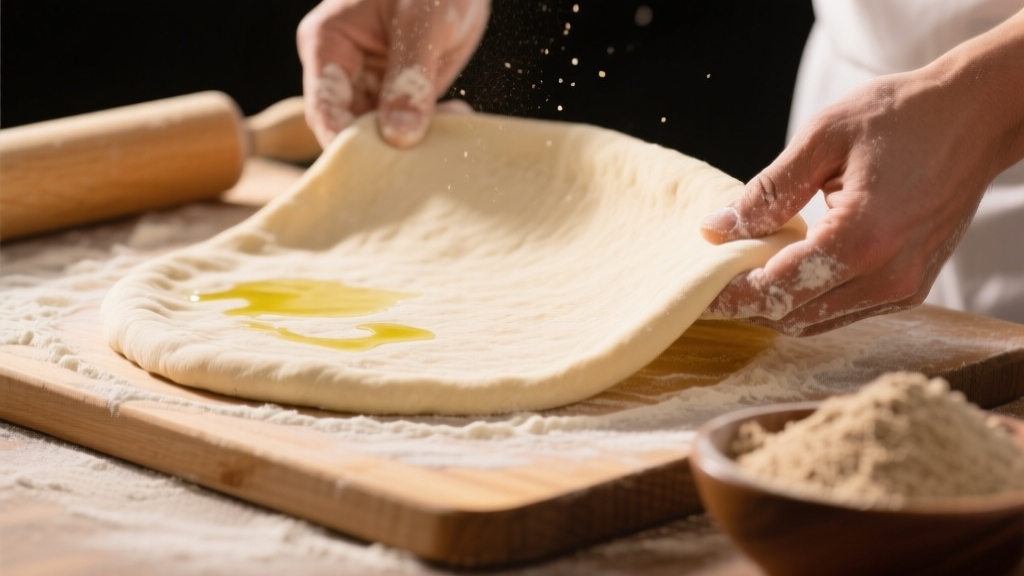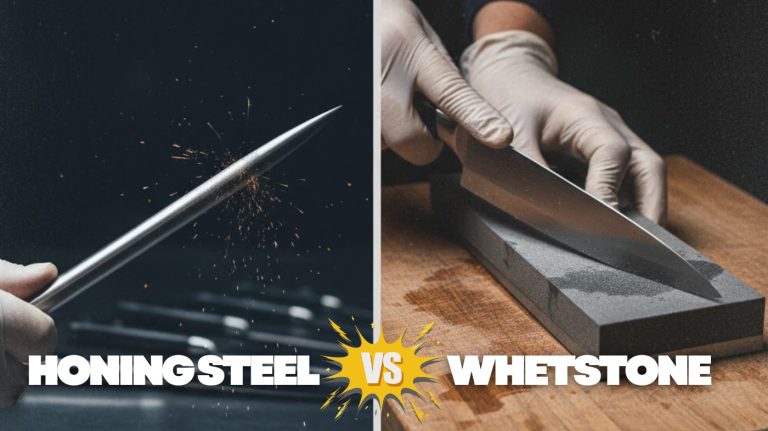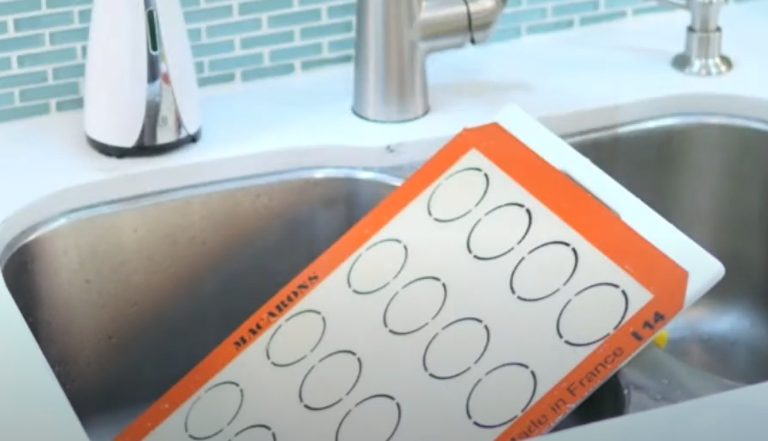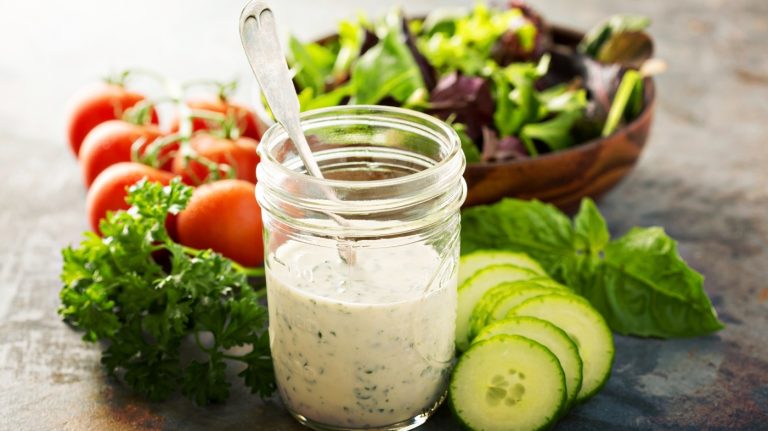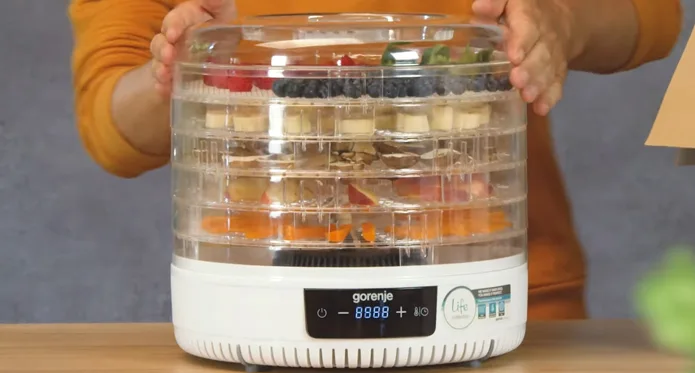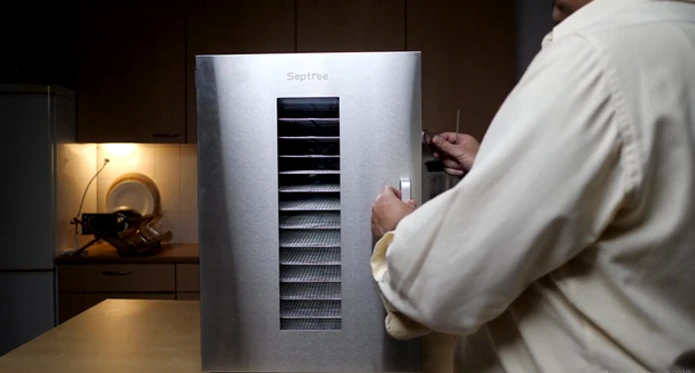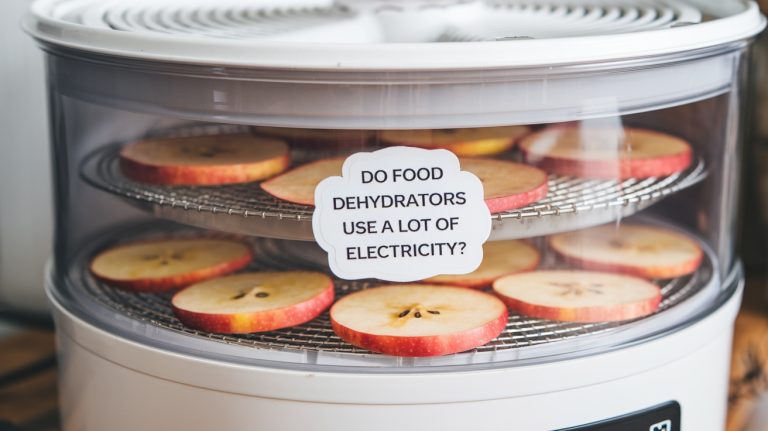Low Cal Pizza Dough: Step-by-Step Guide to Healthier Pies
You can make low-calorie pizza dough by using whole wheat or alternative flours combined with non-fat Greek yogurt, which reduces carbs and boosts protein without adding fat.
Opt for minimal added oils and quick-rise methods like baking powder to save time. These options typically contain under 250 calories per serving and support weight management while maintaining texture.
If you want to maximize nutrition and customize flavors for your goals, exploring ingredient choices and preparation tips will help you craft healthier crusts.
Key Takeaways
- Low-calorie pizza dough often uses whole wheat, cauliflower, or chickpea flour to reduce carbs and increase fiber and protein content.
- Incorporating non-fat Greek yogurt or silken tofu boosts protein while keeping calories and fat low in the dough.
- Thin crusts with minimal kneading and baking at high temperature produce a crispy, light low-calorie pizza base.
- Adding herbs and small amounts of honey or molasses enhances flavor without significantly increasing calories.
- Low-cal pizza dough supports weight management by promoting satiety and reducing carbohydrate-induced insulin spikes.
Nutritional Breakdown of Traditional Pizza Dough
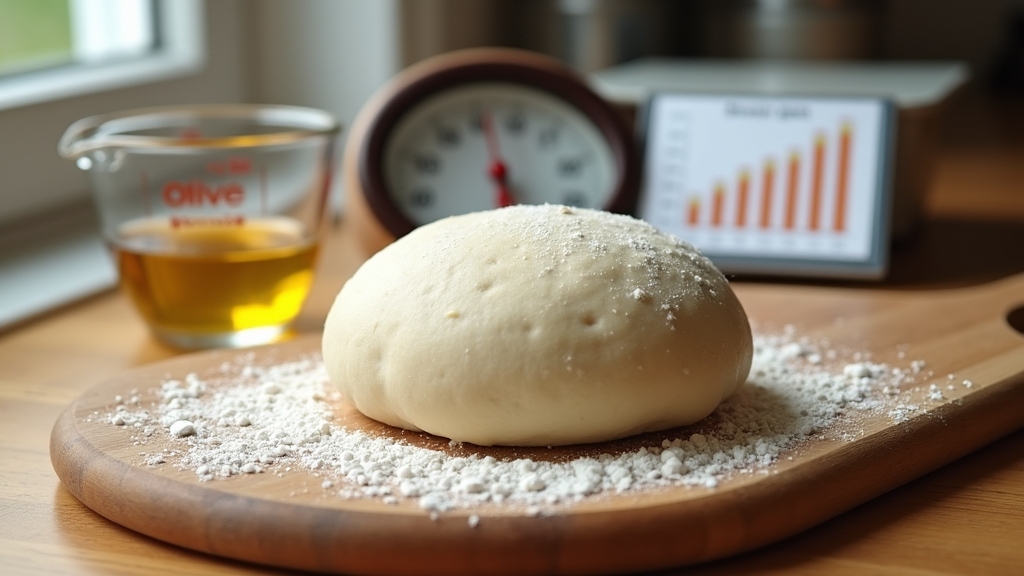
Although traditional pizza dough varies by recipe and serving size, it typically provides between 120 and 250 calories per serving, with carbohydrates making up about 70-75% of those calories.
You’ll find around 24-40 grams of mostly complex carbs and minimal sugars per serving, fueling energy while maintaining a moderate glycemic impact. Protein content ranges from 4 to 8 grams, supporting dough structure and offering slight nutritional benefits.
Fat remains low, usually under 1 gram, though added oils like olive or soybean oil can influence this. Fiber is minimal, about 1 gram, due to refined wheat flour use. Evaluating these macronutrients and micronutrients helps consumers align choices with health goals.
Additionally, the dough supplies modest B vitamins and small mineral amounts from enriched flours, with sodium levels depending on added salt. This breakdown highlights dough’s moderate energy density and nutrient profile.
It is important to note that the type of sauce used on pizza, such as pizza sauce, can also affect the overall nutritional composition and flavor experience.
Ingredients for Low-Calorie Pizza Dough
To create low-calorie pizza dough, you’ll want to focus on using whole wheat self-rising flour or blends with soy and rice flours for added protein and fiber without extra calories. Incorporating non-fat Greek yogurt can boost moisture and protein while keeping fat low.
This dough requires no rising time, making it a quick option for busy schedules. Finally, enhancing flavor with garlic powder, Italian herbs, and careful salt use lets you enjoy tasty dough without adding calories. Choosing ingredients with durability and maintenance in mind can simplify preparation and cleanup.
Essential Low-Cal Ingredients
When crafting low-calorie pizza dough, selecting the right ingredients plays a crucial role in balancing flavor, texture, and nutrition. Whole wheat self-rising flour offers fiber and nutrients while providing structure without added calories from yeast. This type of flour allows the dough to be ready quickly without the need for rising time, making it ideal for fast meal preparation.
Fat-free Greek yogurt replaces oil or butter, binding moisture and enhancing dough elasticity with minimal calories. A pinch of salt and herbs like Italian seasoning boost flavor without adding calories. You can also incorporate alternative flours such as soy or rice flour to reduce calories further and modify texture, but adjust hydration accordingly. Keep added fats minimal, usually a teaspoon of olive oil or none at all, to maintain a low calorie count.
These ingredients create a dough that’s tasty, nutritious, and ideal for calorie-conscious diets without sacrificing quality. Using only a few 4 ingredients in total helps keep the recipe simple and adaptable to various dietary needs.
Protein-Boosting Additions
Since protein plays a key role in satiety and muscle maintenance, boosting it in your low-calorie pizza dough can enhance both nutrition and texture. You can incorporate dairy-based options like nonfat Greek yogurt or blended cottage cheese to add 20–30g protein per serving while keeping calories low.
Alternatively, plant-based proteins such as soy flour or silken tofu increase protein content and improve dough softness. Specialty protein-enriched flours offer another efficient way to raise protein to over 30g per serving, often reducing yeast rising time.
The dough’s texture varies depending on the protein source, with yogurt creating a denser dough and cottage cheese yielding a firmer crust. Choosing ingredients compatible with heat distribution principles ensures even cooking and optimal dough performance.
| Protein Source | Protein per Serving | Benefits | Notes |
|---|---|---|---|
| Nonfat Greek Yogurt | 20–30g | High protein, low calorie | Quick rising, chewy texture |
| Soy Flour | ~24g | Plant-based, calorie-friendly | Enhances structure |
| Protein Flour Blends | 30g+ | High protein, yeast-free | Rapid prep |
| Silken Tofu | Moderate | Soft texture, tangy flavor | Mimics sourdough |
Flavor Enhancers Choices
Although low-calorie pizza dough often limits ingredients, you can still enhance its flavor effectively by selecting specific natural sweeteners, salts, fermentation aids, enzymatic conditioners, and herbs. Balancing these choices ensures taste without adding excess calories or compromising texture.
Consider these options: small amounts of honey or molasses for subtle sweetness and richer aroma; sea salt with trace minerals to enhance flavor and strengthen gluten; cold fermentation or sourdough starter to develop natural tang and complexity. Extending the fermentation time up to 2-3 days can significantly deepen the dough’s flavor without altering calorie content.
Malted barley flour or dough conditioners can improve yeast activity and crust browning. Dried herbs like oregano or basil provide aromatic depth without calories.
Quick Preparation Techniques for Low-Calorie Dough
Mastering quick preparation techniques for low-calorie pizza dough means focusing on simplicity and efficiency without sacrificing texture or flavor. Use minimal ingredients like whole wheat self-rising flour, low-fat Greek yogurt, and a pinch of salt to speed up the process.
Replace yeast with baking powder or soda to cut rising time from hours to minutes. Opt for no-knead or minimal kneading methods and rest the dough briefly, around five minutes, before shaping to maintain dough integrity and avoid overworking the gluten, which aligns with best practices for knife sharpening maintenance.
Roll the dough thinly to ensure faster baking and a lighter crust. Employing a stand mixer can streamline mixing, while preheating your oven and prepping the pan concurrently saves time.
Avoid adding oils to the dough; if needed, apply lightly to ease handling without increasing calories. These steps help you prepare a quick, low-calorie dough efficiently. Many users appreciate that this method achieves a crispy exterior with a soft, chewy interior, enhancing both taste and texture.
Boosting Protein in Pizza Dough Recipes
When you increase protein in your pizza dough recipes, you not only enhance the nutritional value but also improve the dough’s texture and flavor.
Incorporating protein-rich ingredients like Greek yogurt or silken tofu can raise protein content up to 20g per serving while maintaining moisture and chewiness.
Silken tofu, in particular, is about 86% water and adds complete protein, making the dough chewier and more uniform in texture by replacing water with this protein-rich ingredient. Using tools like a food processor can help incorporate these ingredients evenly into the dough for consistent results.
You can also use high-protein flours or add unflavored protein powders for a nutritional boost without altering taste. Carefully balancing leavening agents like yeast and baking powder ensures your dough rises well and stays light.
Consider these options to boost protein effectively:
- Skyr or non-fat Greek yogurt for moisture and protein density
- Silken tofu as a dairy-free, high-protein alternative
- Whole wheat or high-protein self-rising flour blends
- Unflavored whey or plant protein powders mixed in flour
- Ideal yeast and baking powder combinations for texture
Cottage Cheese Crust as a High-Protein Alternative
If you’re looking to increase protein intake while keeping calories moderate, cottage cheese crust offers a compelling substitute for traditional pizza dough. This crust provides 17g to over 40g of protein per serving, supporting muscle maintenance and satiety.
Typically, a small 6-inch crust contains about 163 kcal, with moderate fat (5g–16g) influenced by milk fat percentage and added eggs. Low in carbohydrates (4g to 30g net carbs), it suits low-carb or ketogenic diets. To avoid moisture issues during baking, it is helpful to use techniques to prevent sogginess in the crust.
Key ingredients like small-curd cottage cheese (2%–4% milk fat), eggs, and optional flaxseed meal enhance texture, binding, and nutritional value. Using small-curd cottage cheese with 2% or 4% milk fat is important, as fat-free options do not perform as well in the crust. Baking at 375°F (190°C) for 15–25 minutes after par-baking ensures even cooking and prevents sogginess.
This crust also absorbs herbs well, allowing a flavorful yet health-conscious pizza base.
Calorie Comparisons Among Popular Low-Calorie Pizzas
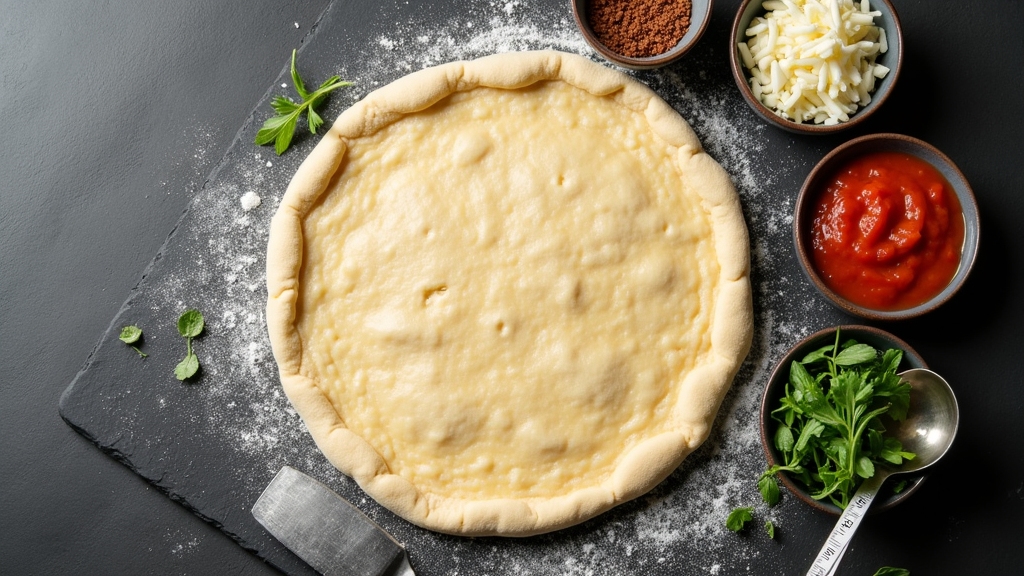
Although choosing a low-calorie pizza often depends on personal taste, understanding calorie differences among popular chain and frozen options can help you make informed decisions. Selecting the right tools in the kitchen, such as a sharp boning knife, can improve preparation efficiency and meal presentation.
Thin crust and veggie-topped pizzas generally pack fewer calories, fat, and sodium than stuffed or pan crusts. Many pizza chains offer thin crust options as a calorie-lighter alternative to traditional crusts.
Here’s a quick comparison:
- Domino’s Thin Crust with Spinach & Mushrooms: 120 calories, 7g protein
- Pizza Hut Thin ‘N Crispy Veggie Lover’s: 100 calories, 5g saturated fat
- Little Caesars Thin Crust Cheese: 148 calories, 8g protein
- Amy’s Margherita Thin Crust (1/3 pie): 270 calories, 10g protein
- Cappello’s Margherita (1/2 pizza): 480 calories, 14g protein but high sodium
Dietary Benefits and Customization of Low-Calorie Dough
Understanding the calorie content of popular low-calorie pizzas helps you make smarter choices, but focusing on the dough itself offers even greater control over your meal’s nutritional profile.
Low-calorie doughs typically contain 240–346 calories per crust and provide increased dietary fiber (3 g+ per 100 g) when made with whole grain or alternative flours, improving digestion.
The carbohydrates: 50g in 100g of pizza crust serve as the main energy source, making dough an important consideration for energy intake. Like preparing Slim Jims, maintaining uniform texture in dough contributes to consistent cooking results.
You can customize dough by using cauliflower, chickpea, or whole wheat flour to boost protein (4–8 g per serving) and reduce carbs. Adjusting thickness lowers calorie and carbohydrate intake, while adding egg whites or seeds enhances protein and healthy fats without extra calories.
This approach supports weight management by promoting satiety and minimizing insulin spikes, enabling you to enjoy pizza that fits your nutritional goals.
Frequently Asked Questions
How Does Low-Calorie Pizza Dough Affect Baking Time and Texture?
You’ll notice low-calorie pizza dough often bakes slightly faster due to reduced moisture and density, with pre-baking times around 3-5 minutes before toppings.
The texture tends to be softer and less chewy since it uses alternative flours or less fat, making the crust less rich and airy.
To get a crispier edge, you might bake at higher temperatures or spray lightly with oil.
Adjust your baking time carefully to avoid dryness or burning.
Can Low-Calorie Pizza Dough Be Frozen and Reheated Without Quality Loss?
Yes, you can freeze and reheat low-calorie pizza dough without significant quality loss if you follow proper steps. Freeze it tightly wrapped at -18°C or lower to prevent freezer burn.
Defrost it overnight in the fridge to maintain moisture. Reheat in a preheated oven at 350-375°F using a pizza stone or pan for even cooking.
Avoid microwaving if you want a crisp crust. This method preserves texture and freshness effectively.
What Are the Best Storage Methods for Prepared Low-Calorie Pizza Dough?
You’d think pizza dough loves the cold, and you’re right. Store your low-calorie dough in lightly oiled, airtight containers to keep it fresh.
Refrigerate up to 5 days or freeze for 2–3 months to avoid freezer burn.
Thaw it overnight in the fridge, then bring it to room temperature before baking.
Use individual lidded vessels for proofing to let your dough rise without drying or sticking.
Simple, right?
How Does Low-Calorie Dough Compare in Taste to Traditional Yeast Dough?
You’ll find low-calorie dough tastes milder and less complex than traditional yeast dough, mainly due to reduced yeast and shorter fermentation. Traditional dough, especially with fresh or active dry yeast, develops richer, savory flavors from longer fermentation.
Low-cal dough often lacks that depth, sometimes feeling bland or flat.
However, sourdough varieties, though lower in calories, can offer a tangy, more nuanced flavor that surpasses typical yeast dough complexity.
Are There Gluten-Free Options Available for Low-Calorie Pizza Dough Recipes?
Yes, you’ll find plenty of gluten-free options that keep calories low—like cauliflower crusts with just 60 calories per 340 grams. Using raw cauliflower, Greek yogurt, or gluten-free self-raising flour blends, you can make doughs that are both gluten-free and low-calorie.
These recipes often use xanthan gum or baking powder instead of yeast, giving you a tasty, healthier alternative without sacrificing texture or rising ability.
Healthy Pizzas Start with the Right Dough
Now that you’ve uncovered the secrets of low-calorie pizza dough—from boosting protein with cottage cheese crusts to quick prep hacks—you’re ready to craft healthier pies that don’t skimp on flavor. Just like a Renaissance alchemist turning base metals into gold, you can transform simple ingredients into a nourishing meal.
By choosing smarter options and customizing your dough, you’ll enjoy pizza that supports your dietary goals without sacrificing taste or satisfaction.

